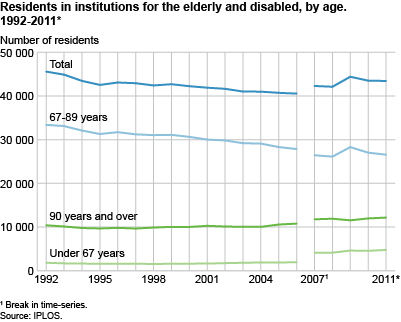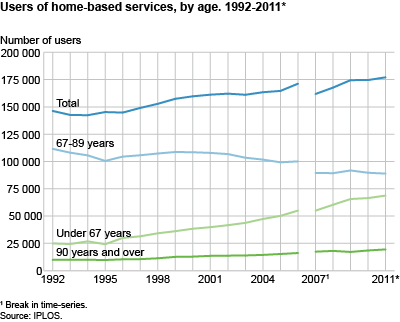Content
Published:
This is an archived release.
More to the youngest and the over 90s
Figures for users of home nursing and home help increased slightly amongst the young and the elderly over the past year. Much of this can be explained by corresponding changes in the population for these groups, but also by the youngest - especially those with greatest assistance needs - receiving more services. An increase in the number of full-time equivalents (FTEs) and fewer absences have kept FTEs per user stable.
Even with small changes from 2010 to 2011, figures illustrate a clear development over the past few years. In 2011, 240 more rooms were distributed over somewhat fewer institutions, making the single room portion 96.9 per cent. The number of retirement beds is still in decline, by around 200 beds from last year, whilst the number of nursing home beds increased by somewhat less.
There has been a decrease in the number of institution residents within the age group 80-89 years, and an equivalent increase amongst the youngest and oldest. The increase has been greatest for those under the age of 67, which can also explain the rise in short-term residencies. At the same time there has been a 4 per cent increase in the number of residents within dwellings used by the local authorities. Roughly half of these have round the clock staffing. Within the different age groups, the greatest increases can be found for residents under the age of 67 and over the age of 90. The number of residents in these two groups together have risen by approximately 6 per cent in institutions and more than 14 per cent in dwellings for the aged and disabled.
Highest growth in home nursing
In total, the number of users of all nursing and care services increased by some 3 000 from 2010. Fewer utilize home help alone and long-term residency in institutions. Meanwhile, the number of users of home nursing has increased, both alone and in combination with home help, which constitute virtually half of all service users.
There were approximately 177 000 users of home nursing and home help at the end of 2011, which is 2 500 more than the previous year, and while the number of those within the age group 67-89 years has slightly declined, there has been 3 000 more users under 67 and over 90 years. Figures show a large increase for these groups over the last two years - 5 and 13 per cent respectively. Much of this can be explained by changes in the population. The number of users relative to groups’ share in the population has only increased for those under the age of 67.
There have been more recipients of care services offered to those still living in their own homes, services mainly directed towards the youngest. Although 80-90 per cent of users are under the age of 67, increased use of respite care and personal support contact is most evident among those over 67.
In addition, the number of recipients of user-controlled assistance has increased by 9 per cent since 2010. Figures show more recipients under the age of 67, but greater increase in percentages among the elderly.
More assigned hours to younger users
With a stable number of institution residents, the increasing number of users of all nursing and care services is entirely due to new users of home-based services. This was compensated with 2 700 more FTEs. After deduction of absences, which have decreased by 0.5 percentage points, figures indicate a small increase in FTEs per user.
Users of home nursing and home help received on average 7.9 assigned hours per week, slightly more than in 2010. In general, figures show that the number of assigned hours increases together with need of assistance. The youngest age group receives on average more assigned hours on all levels, especially with extensive need of assistance, and while the elderly with greatest assistance needs become institution residents, the youngest are usually offered an extensive range of home-based services.
For more information about IPLOS: http://www.ssb.no/a/innrapportering/iplos/
|
Tables in this article do not show entire time series. However, missing periods can be found in previously published articles (available in the left menu). |
Tables:
- Table 1 Institutions for the aged and disabled. 1996-2011
- Table 2 Residents in institutions for the elderly and disabled, by age. 1992-2011
- Table 3 Residents in dwellings for the aged and disabled. 1994-2011
- Table 4 Users of home-based services, by age. 1992-2011
- Table 5 Users of home based services, by kind of service. 1992-2011
- Table 6 Users of home-based services and residents in institutions for the elderly and disabled. Need for assistance and kind of service. 2007-2011
- Table 7 Average numbers of assigned hours per week for users of home help and home nursing. Age and need for assistance. 2011*
- Table 8 Recievers of respite care, personal support contact, recievers with next of kins receiving pay for caring work and user-controlled assistance. Age. 2002-2011
- Table 9 Full-time equivalents (FTEs) and absence within the nursing and care services. 1994-2011
This page has been discontinued, see Care services, Annually.
Contact
-
Dag Ragnvald Abrahamsen
E-mail: dag.ragnvald.abrahamsen@ssb.no
tel.: (+47) 40 90 25 46
-
Øyvind Isachsen Berntsen
E-mail: oyvind.berntsen@ssb.no
tel.: (+47) 40 90 23 28
-
Bjarne Tautra Hoen
E-mail: bjarne.hoen@ssb.no
tel.: (+47) 40 90 25 99
-
Linda M. Allertsen
E-mail: linda.allertsen@ssb.no
tel.: (+47) 97 09 97 51


